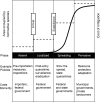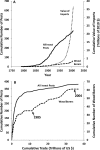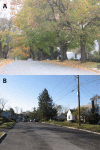Nonnative forest insects and pathogens in the United States: Impacts and policy options
- PMID: 27755760
- PMCID: PMC6680343
- DOI: 10.1890/15-1176
Nonnative forest insects and pathogens in the United States: Impacts and policy options
Abstract
We review and synthesize information on invasions of nonnative forest insects and diseases in the United States, including their ecological and economic impacts, pathways of arrival, distribution within the United States, and policy options for reducing future invasions. Nonnative insects have accumulated in United States forests at a rate of ~2.5 per yr over the last 150 yr. Currently the two major pathways of introduction are importation of live plants and wood packing material such as pallets and crates. Introduced insects and diseases occur in forests and cities throughout the United States, and the problem is particularly severe in the Northeast and Upper Midwest. Nonnative forest pests are the only disturbance agent that has effectively eliminated entire tree species or genera from United States forests within decades. The resulting shift in forest structure and species composition alters ecosystem functions such as productivity, nutrient cycling, and wildlife habitat. In urban and suburban areas, loss of trees from streets, yards, and parks affects aesthetics, property values, shading, stormwater runoff, and human health. The economic damage from nonnative pests is not yet fully known, but is likely in the billions of dollars per year, with the majority of this economic burden borne by municipalities and residential property owners. Current policies for preventing introductions are having positive effects but are insufficient to reduce the influx of pests in the face of burgeoning global trade. Options are available to strengthen the defenses against pest arrival and establishment, including measures taken in the exporting country prior to shipment, measures to ensure clean shipments of plants and wood products, inspections at ports of entry, and post-entry measures such as quarantines, surveillance, and eradication programs. Improved data collection procedures for inspections, greater data accessibility, and better reporting would support better evaluation of policy effectiveness. Lack of additional action places the nation, local municipalities, and property owners at high risk of further damaging and costly invasions. Adopting stronger policies to reduce establishments of new forest insects and diseases would shift the major costs of control to the source and alleviate the economic burden now borne by homeowners and municipalities.
Keywords: disease; forest; insect; invasive; pathogen; policy.
© 2016 by the Ecological Society of America.
Figures




References
-
- Albani, M. , Moorcroft P. R., Ellison A. M., Orwig D. A., and Foster D. R.. 2010. Predicting the impact of hemlock woolly adelgid on carbon dynamics of eastern United States forests. Canadian Journal of Forest Research 40:119–133.
-
- Anagnostakis, S. 2001. The effect of multiple importations of pests and pathogens on a native tree. Biological Invasions 3:245–254.
-
- APHIS, 2015a. USDA Animal and Plant Health Inspection Service (APHIS), Washington, DC. https://www.aphis.usda.gov/aphis/ourfocus/planthealth/sa_domestic_pests_.... July 9, 2015.
-
- APHIS, 2015b. New Pest Advisory Group (NPAG). USDA Animal and Plant Health Inspection Service (APHIS), Washington, DC. https://www.aphis.usda.gov/aphis/ourfocus/planthealth/ppq-program-overvi.... June 26, 2015.
-
- Aukema, J. E. , McCullough D. G., Von Holle B., Liebhold A. M., Britton K., and Frankel S. J.. 2010. Historical accumulation of nonindigenous forest pests in the continental United States. BioScience 60:886–897.
Publication types
MeSH terms
LinkOut - more resources
Full Text Sources
Other Literature Sources

